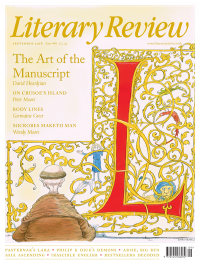Jonathan Meades
Going Underground
The Tunnel Through Time: A New Route for an Old London Journey
By Gillian Tindall
Chatto & Windus 306pp £20
Crossrail, which will eventually come to be known as the Elizabeth Line, is currently an accursed presence in central London, the most massive obstruction to traffic in an agglomeration doldrummed by such obstructions. The area around Centre Point is perpetually chaotic. Gillian Tindall’s bien-pensant contempt for that building is undermined by her getting the architect’s given name wrong: Colonel Seifert was Richard not Robert (the actual designer was George Marsh). It is hardly astonishing that she should be unsympathetic to buildings that rise high above the land, for her bias is firmly towards all that is subterranean, hidden, buried, cavernous. Priest-holes and secret passages, covert rivers, the compressed remains of forgotten houses and, fine phrase, ‘vestigial human matter’ – these whet her appetite. They fire a compulsion to explain in the most minute detail and to link the past to the present. Tindall is, of course, not the only writer to be so preoccupied. There is no burgh in Britain without its complement of burrowing ‘local’ historians, archaeologists and geologists, recounting their troves to anyone who’ll listen. What differentiates Tindall from these is the sheer scale of her enterprise and the breadth of her knowledge, which stray far beyond the ‘local’. She employs disciplines more commonly used in the study of tumuli or crypts or (increasingly) Second World War bunkers to scrutinise the route of Crossrail, the largest infrastructure project in Europe, in what was, until a few months ago, the major city in Europe. It is salutary to note that between his two stints as mayor of London in 1283 and 1298, Henry Waleys (aka le Wallais) served as mayor of Bordeaux.
The new line is here a form of armature to which can be appended multiple histories, tales of olfactory woe, folkloric gleanings, graveyard scares and a bracing dose of scepticism. Tindall is well aware of history’s dependence on extant histories and the ease with which tall stories, conspiracy yarns

Sign Up to our newsletter
Receive free articles, highlights from the archive, news, details of prizes, and much more.@Lit_Review
Follow Literary Review on Twitter
Twitter Feed
It wasn’t until 1825 that Pepys’s diary became available for the first time. How it was eventually decrypted and published is a story of subterfuge and duplicity.
Kate Loveman tells the tale.
Kate Loveman - Publishing Pepys
Kate Loveman: Publishing Pepys
literaryreview.co.uk
Arthur Christopher Benson was a pillar of the Edwardian establishment. He was supremely well connected. As his newly published diaries reveal, he was also riotously indiscreet.
Piers Brendon compares Benson’s journals to others from the 20th century.
Piers Brendon - Land of Dopes & Tories
Piers Brendon: Land of Dopes & Tories - The Benson Diaries: Selections from the Diary of Arthur Christopher Benson by Eamon Duffy & Ronald Hyam (edd)
literaryreview.co.uk
Of the siblings Gwen and Augustus John, it is Augustus who has commanded most attention from collectors and connoisseurs.
Was he really the finer artist, asks Tanya Harrod, or is it time Gwen emerged from her brother’s shadow?
Tanya Harrod - Cut from the Same Canvas
Tanya Harrod: Cut from the Same Canvas - Artists, Siblings, Visionaries: The Lives and Loves of Gwen and Augustus John by Judith Mackrell
literaryreview.co.uk